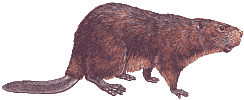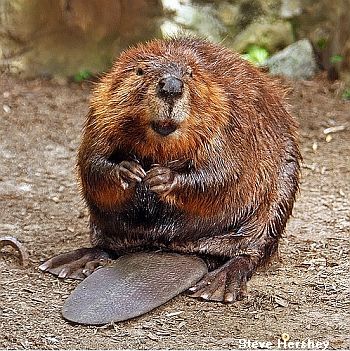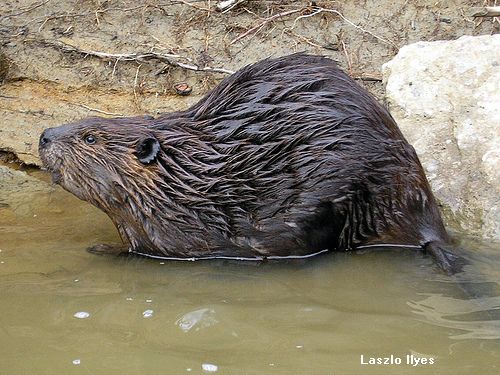

1. Where the beaver lives
Mud is plastered on the outside of the lodge to make it strong. This prevents enemies from breaking in. The mud also helps keep the inside warm during the winter. Beavers may also build dens or burrows along river banks. Sometimes they live in these bank burrows while they are building their lodge. The burrows are also a place to hide from enemies.  Creative Commons License Attribution-ShareAlike 2.0 Generic
a beaver's webbed hind foot a beaver's front foot The beaver's legs are short. It is not able to move quickly on land. But the beaver is a strong swimmer under water and on the surface of the water. The large hind feet are webbed. The small front paws are not .
The front feet have sharp claws. The beaver uses the claws for digging up mud and stones. The beaver uses its front feet for carrying mud and branches. With its back feet the beaver spreads a waterproofing oil on its fur. The beaver's fur has to be oily to keep the animal waterproof.  4. Food Beavers eat the bark and leaves of trees . Their favorite tree is the aspen. Beavers also eat grasses, berries and waterplants. 5. Adaptations The beaver is well adapted for swimming. It can see well under water. Over its small eyes there is a thin see-through lid. The beaver's nostrils and ears can be closed when swimming . The front teeth are very strong and sharp for gnawing and cutting down trees. Beavers pull smaller branches with their teeth. Bigger logs are rolled down to the pond with their front paws or their nose or the top of their heads. The trees are dragged to the water. A dam is made of branches, mud and rocks. This dams holds back the water amd a deep pond is formed. The pond must be deep enough so water will not freeze to the bottom. In the winter the beaver family stays inside a lodge. There can be six or more in the lodge including parents, yearlings and kits. They do not hibernate. Enough food must be stored to last all winter. The beaver's food pile of twigs and branches is at the bottom of the pond close to the entrance to the lodge. During the winter the beaver dives down to get some food. 6. The young Beavers mate for life. Early in the summer ( May or June ) the female has a litter of three or four kits. The newborn have fur, teeth and can see and walk. The babies remain inside for about a month. The yearlings act as babysitters for the new litter. During their second year, young beavers help their parents repair the dam and lodge and gather food for winter. Young beavers stay with their parents until they are two years old. 7. Enemies Wolves, coyotes, bears, the wolverine and lynx are enemies of the beaver. Beavers can be easily caught when they are on land. River otters have been known to slip into the lodge and kill the kits. In the winter when the water is frozen, predators can walk right up to the lodge. These animals may try to break into the lodge. 8. The Wetlands Indians called the beaver the "sacred centre" of the land because beavers create habitats for other mammals, fish, turtles, frogs, birds and ducks. Beavers can change the landscape by damming streams. Much of the flooded area becomes wetlands. Many endangered and threatened animals rely on the wetlands for their survival. |